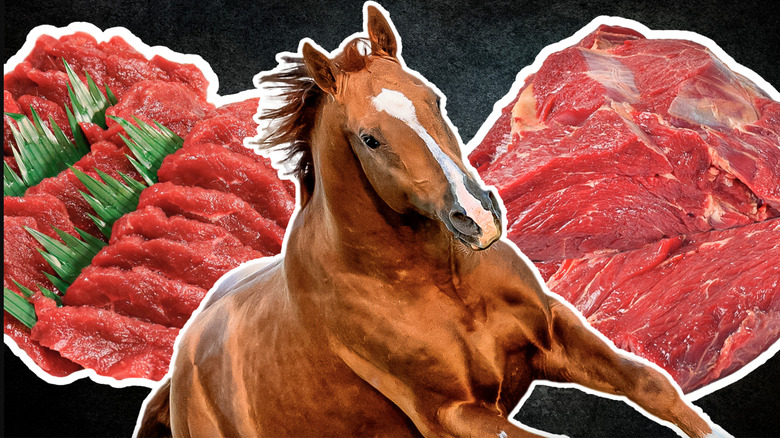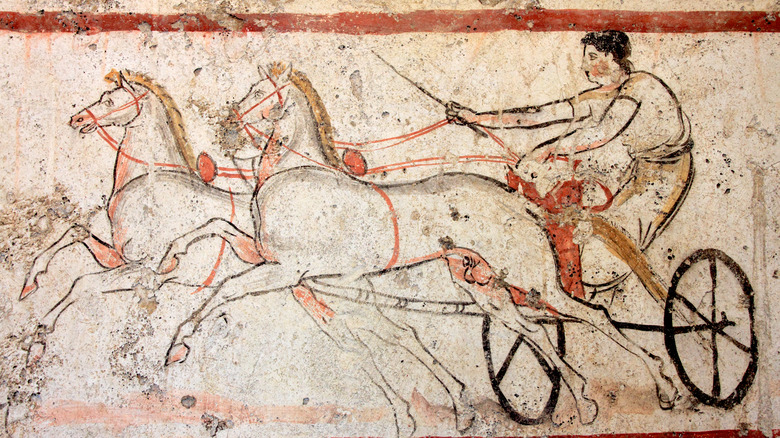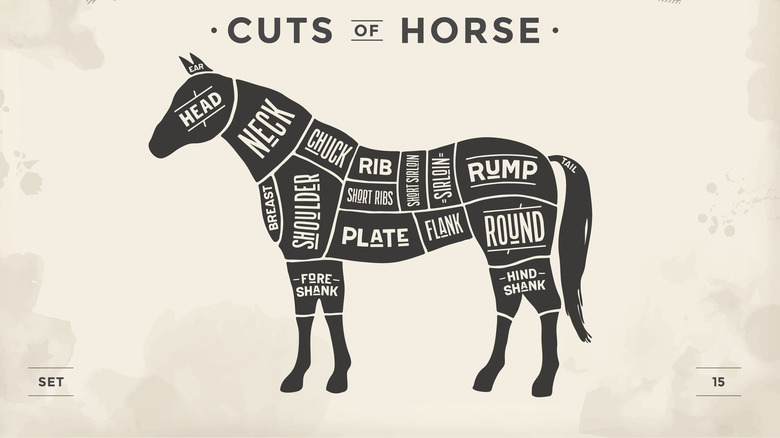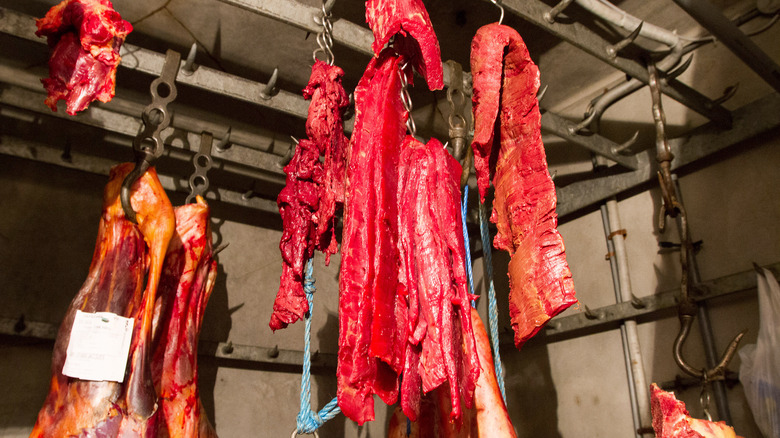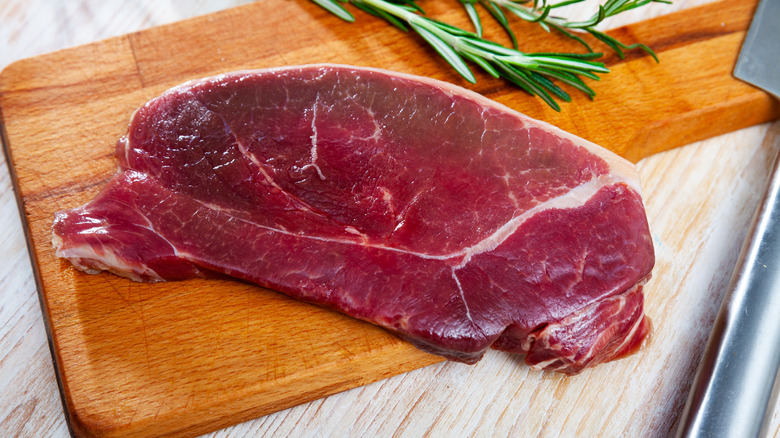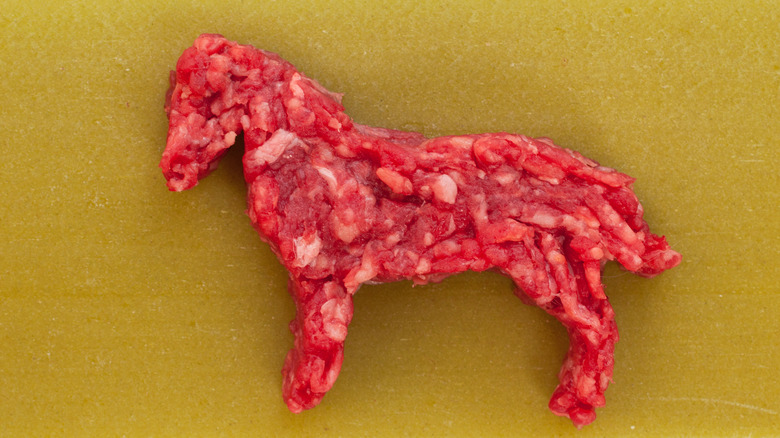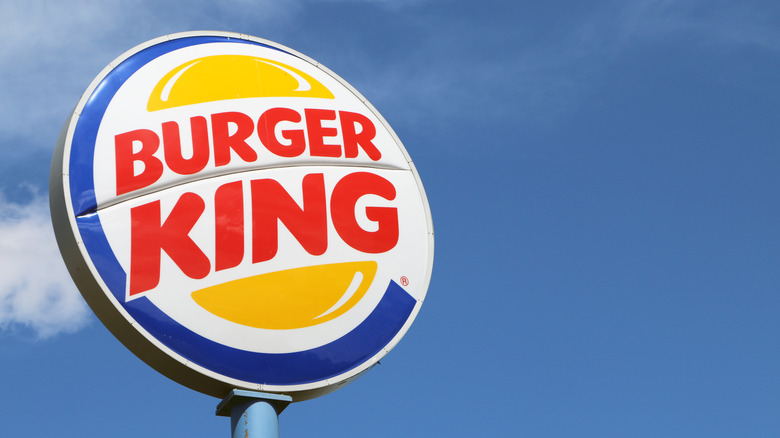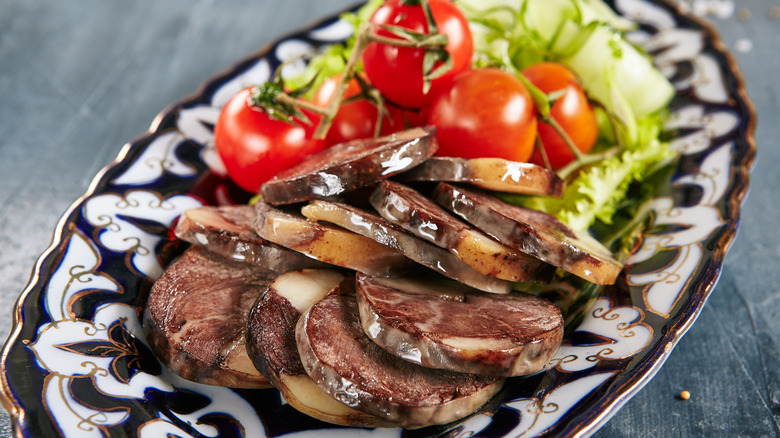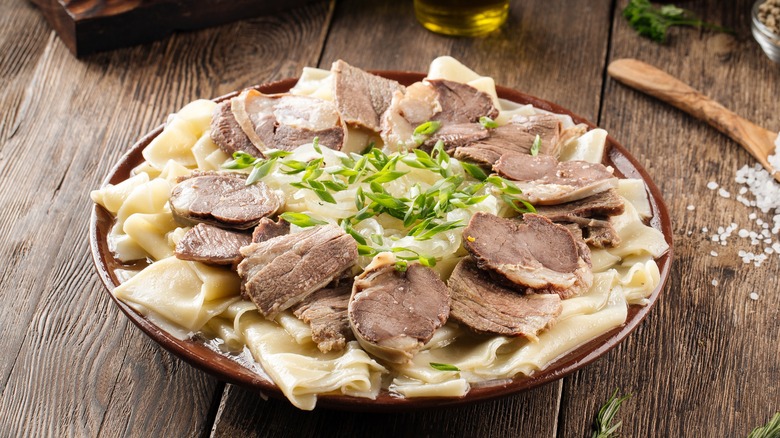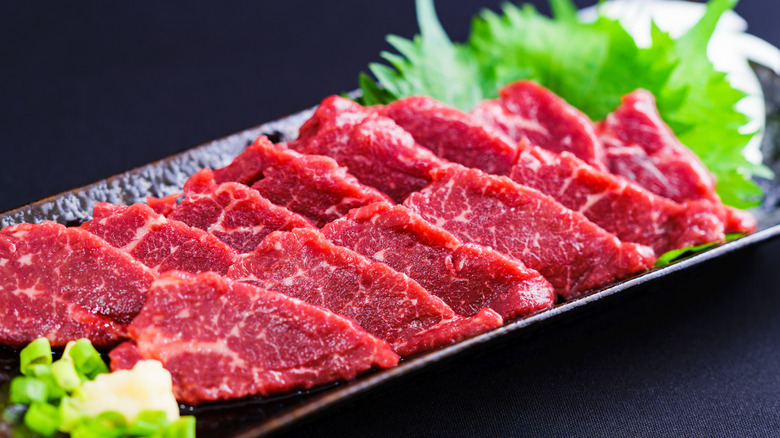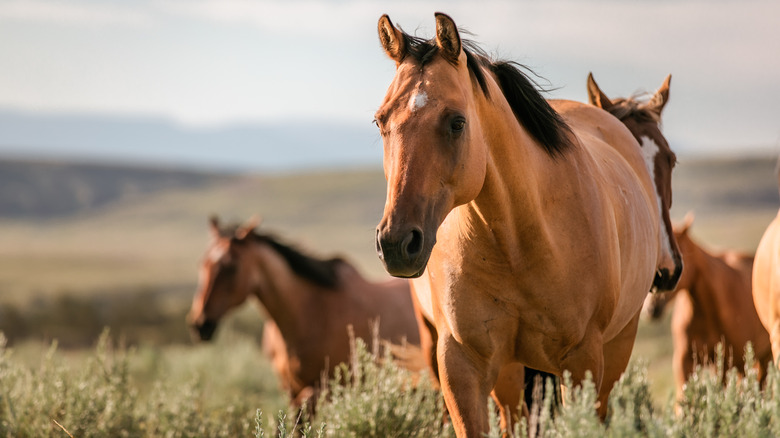Horse Meat: 10 Facts About The Controversial Protein
If you don't find the concept of eating Mister Ed or Black Beauty appealing, you're not the only one. While eating horse meat was prevalent in the past, the practice has gradually fallen out of favor in many parts of the world. The decrease in horse meat consumption can be primarily attributed to a shift in attitudes towards animals, with horses being seen more as working animals and companions rather than as a source of sustenance. Even so, according to the OEC, the U.S. still imported $235,000 worth of equine meat in 2022, mostly from Canada.
While eating horse meat may be considered taboo in the U.S., many cultures view chevaline — as it's referred to in France — as a staple and even a delicacy. And it's not just people in locations such as China, Kazakhstan, and Kyrgyzstan who indulge in the divisive protein; horse meat can be found on the menus of European countries such as Italy and Belgium. Those who have sampled horse meat often compare it to beef, saying that it's a little redder in appearance, more tender in texture, and sweeter in flavor.
Are you ready to find out more about the history, cultural significance, and health benefits of horse meat? Here are some fascinating facts about this distinctive culinary choice!
Horse meat has been consumed since ancient times
Our predecessors the Neanderthals used horse meat for sustenance more than 400,000 years ago. Whether nomadic or pastoral, prehistoric people also killed horses for meat. In fact, a drawing of horses discovered in the Chauvet Cave in France is said to date back between 30,000 and 32,000 years. Horses were domesticated around 4,500 B.C., and while equines were still slaughtered for their meat, they were also used for transport and as working companions.
Horse meat fell out of favor with Christians in 732 A.D., after Pope Gregory III declared it to be pagan and ritualistic in origin. Condemning it as "filthy and abominable," the Pontiff imposed a ban on the consumption of horse meat, leading to a decline in its popularity across Europe. Some have suggested that the Pope may have had ulterior motives when issuing the ban, specifically to secure a steady supply of horses for warfare. Interestingly, Christians were relatively late in prohibiting the consumption of horse meat, considering that it had already been banned in Islamic and Jewish societies, as well as by the Greeks and Romans.
Horse meat was popular in the U.S. during World War II
While eating horse meat may be frowned upon in the U.S. today, this wasn't always the case. In fact, equine meat became very popular in the country during World War II, mainly due to the scarcity of beef. While most meats were rationed during that period, horse meat remained exempt from such restrictions. Moreover, it underwent government inspection, providing families with reassurance about the quality of the product they were consuming.
The practice of hippophagy — or eating horse meat — did seem to vary by state, however. For instance, a 1942 article in The Pittsburgh Press reported that Pennsylvania had banned the consumption of horse meat, calling it "unfit for food." Breach of the law could result in hefty fines of between $50 and $100 or even 30 days in jail. At the same time, one wholesale company in Boston revealed that it was already selling its second 30,000-pound batch of horse meat for the week.
Even after the war, horse meat remained an alternative to beef for Americans, particularly since it cost around half the price. In the 1940s and '50s, there was an underground market for horse meat, with the protein purchased at pet stores for human consumption. Later, during the economically turbulent period of the early 1970s, which was marked by high inflation rates, a Connecticut butcher reported that they were selling as much as 6,000 pounds of horse meat per day.
The last horse slaughterhouse in the U.S. closed in 2007
The last U.S. horse slaughterhouse ceased operations in 2007, but it may not be for the reasons you think. Rather than a direct federal ban on killing horses for food, the practice was discontinued indirectly when the federal government prohibited the funding of USDA inspections of horse slaughterhouses across the country. This move, in turn, made it impossible for horse slaughter facilities to comply with the Federal Meat Inspection Act of 1906, essentially forcing them to close their doors.
The Obama Administration repealed a five-year ban on the funding of horse slaughterhouse inspections in 2011; nevertheless, since no federal funding has been issued to resume the evaluations, the slaughterhouses remain closed.
During their final year of operations, the remaining three slaughterhouses in Texas and Illinois killed over 100,000 horses for commercial purposes, with most of the meat shipped to Asia and Europe. In comparison, in 1990, the U.S. had 14 horse slaughterhouses that destroyed 345,700 animals, indicating a decreasing interest in the red meat both at home and abroad.
Horse meat is legal in most U.S. states
Since the commercial sale of horse meat is prohibited across the U.S., it may come as a surprise to some that this isn't the case for the consumption of equine meat under federal law. The caveat is that you slaughter your own horse. In 2023, the practice of killing horses for meat is legal in most states, as long as it isn't done for commercial purposes. The only states where horse meat is currently illegal are Texas, California, Florida, New Jersey, New York, Georgia, and Illinois.
While there are no horse slaughter plants in the U.S., not many are aware that American horses are still being shipped to slaughter facilities in Canada and Mexico. The truck journeys often extend beyond 24 hours, with the horses confined in cramped spaces without access to food and water. While disturbing, the practice is on the decline. While on average 137,000 horses were transported across the border each year between 2012 and 2016, by 2022, this number plummeted to below 20,000.
We all may have inadvertently eaten horse meat
If you think you have never had horse meat, think again. In 2013, horse beef was found in multiple beef products across the U.K. Also humorously referred to as "Horsegate," the scandal led to millions of products being pulled off the shelves (or rather out of the freezers). The fiasco took place after the Food Standards Agency Ireland (FSAI) found that over a third of the frozen products it tested contained horse DNA. Later, further tests found that some so-called beef products were in fact 100% horse. Two such products were Comigel's frozen spaghetti Bolognese and lasagna sold at Aldi, Tesco, and Findus.
While uncovered in Ireland, the fraud had repercussions across Europe, where many of the contaminated products were also sold. And the fiasco didn't just undermine consumer trust and emotional well-being, but it could have had disastrous consequences. This is because horse meat can contain bute — an anti-inflammatory drug given to horses — which can be harmful to humans. In fact, after testing the meat sold by Farmbox Meats in West Yorkshire, which was embroiled in the scandal, the Food Safety Authority discovered that a significant portion of it contained bute.
Horse meat has been found in fast food
Fast food restaurants weren't exempt from the controversy ignited by the 2013 Horsegate scandal. The fast food giant Burger King admitted that some of its burger meat in Britain and Ireland had been contaminated with horse meat. According to The Guardian, the chain's representatives revealed that "very small trace levels" of equine DNA had been found in the meat at its plants. However, they also denied that any of the meat examined at the chain's restaurants tested positive for horse DNA. In response to the discovery, Burger King ceased sourcing its meat from Silvercrest in Ireland, a subsidiary of the ABP Food Group named by the FSAI as one of the main culprits in the scandal.
Following suit, Taco Bell also came clean about the fact that its food had been contaminated with horse meat. While Taco Bell's U.S. outlets remained unaffected by the scandal due to different suppliers, the chain promptly removed ground beef products from a handful of its restaurants in Britain. At the time, Taco Bell in the U.S. issued a statement, explaining, "Our domestic restaurants have not been, and will not be, impacted because we do not use any meat from Europe. Like all beef in the United States, ours is USDA inspected and then passes our own 20 quality checkpoints."
Horse meat has health benefits
While horse meat consumption may raise a few eyebrows in some parts of the world, the protein is a great option for carnivores seeking lean and nutrient-dense meat. Equine meat is low in fat and cholesterol. It's also rich in iron, with 300 grams satisfying the recommended daily intake of the mineral for adults. In addition, horse meat contains vitamins B3, B6, and B12, all of which play a crucial role in supporting various aspects of our overall health and well-being. Equine meat is also packed with omega-3 fatty acids, with 100 grams of the protein containing around 360 milligrams of the stuff — far more than the 21 milligrams of omega-3 fatty acids found in 100 grams of strip steak, according to KQED.
In 2007, Chef Gordon Ramsay caused a bit of a stir when he said that horse meat was both delicious and nutritious during the cooking reality show "The F-word." In fact, he went as far as urging Brits to switch to eating the red meat, describing it as "slightly gamey" and "packed with protein" in an interview with the Telegraph. The controversial "The F-word" episode saw its presenter Janet Street-Porter visit a French horse farm and then cook up a horse meat storm at the Cheltenham racecourse.
Horse meat is a culinary staple in some countries
While in the U.S. — and a few other countries such as the U.K., Germany, and South Korea — eating horse meat is taboo, this is by no means a global sentiment. In fact, horse meat is a dietary staple in more than half of the world's nations. The biggest horse meat producer in the world is China, slaughtering 1.5 million horses for 200,000 tons of equine meat in 2018 alone, a lot of it for export. Surprisingly, Belgium holds the title of the largest consumer of equine meat per capita, importing around 44 million pounds of the stuff a year. Some other European countries that indulge in horse meat include Italy, France, and the Netherlands.
Further afield, horse meat is also a big thing in Kyrgyzstan and Kazakhstan, perhaps reflecting those countries' nomadic history. The most renowned culinary horse meat creation in Kazakhstan is beshbarmak, which combines the red meat with pasta sheets and onions. While horse meat is also popular in Kyrgyzstan, the country prides itself on another horse-derived delicacy — fermented horse milk, or kumis. The Central Asian country has even started using mares' milk to draw tourists eager to immerse themselves in the traditional Kyrgyz culture.
The Japanese indulge in raw horse meat
While the squeamish may cringe at the sound of horse meat dishes, the Japanese have taken eating the red meat to a whole new level. In Japan, horse meat, known as baniku, is commonly served in hot pots and stews — but this isn't all. One of the country's delicacies is a sashimi-style version of the meat called basashi or sakura niku (cherry blossom meat) due to its vibrant hue. The dish is a specialty in Kumamoto, a prefecture on the southwestern island of Kyushu, a region that's also the country's primary source of horse meat.
Just like other sashimi, basashi usually comes thinly sliced and is dipped in soy sauce and horseradish. It's also commonly served with garlic and grated ginger. Basashi is normally made from three cuts of horse meat. The most sought-after of the three is futaego, a crunchy and fatty cut from the horse's neck. The other two choicest pieces include a lean cut and a marbled option. Basashi ranges in color from light to deep red, depending on the age of the horse — typically the younger the horse, the lighter the meat. While this doesn't fill us with confidence, basashi is often served frozen to curtail the spread of harmful bacteria.
Horse meat is relatively environmentally-friendly
There're several reasons why meat production as we know it today is unsustainable. Livestock farming takes up around 30% of land, leading to deforestation and loss of habitat for wildlife. Cattle are also one of the main contributors to climate change and global warming. Unlike horses, cows break down food through a process called enteric fermentation, which releases methane, a potent greenhouse gas that constitutes a global warming hazard that's 25 times greater than carbon dioxide.
In 2015, The Guardian reported on America's wild horse problem. At the time, the U.S. was home to around 50,000 wild horses, close to double the threshold set by the Bureau of Land Management (BLM). This number has only increased over time, reaching more than 83,000 in 2023. Since America's wild horse overpopulation has had detrimental effects on the environment and other animals sharing their habitat, normalizing the consumption of horse meat in the U.S. could go a long way to keeping their numbers in check.
